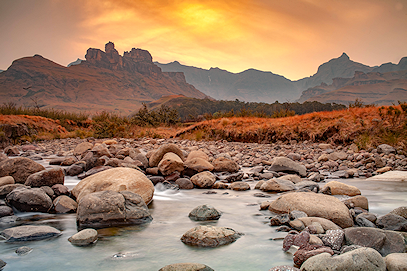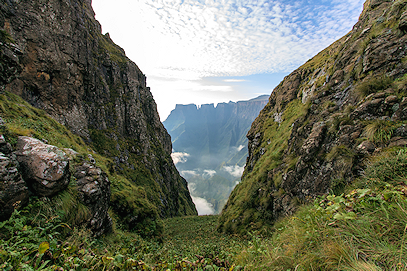South Africa's uKhahlamba-Drakensberg National Park
Help Me Plan- Home
- >
- African Travel
- >
- South Africa
- >
- National Parks
- >
- Ukhahlamba-Drakensberg National Park
Ukhahlamba-Drakensberg National Park Destination Guide
uKhahlamba-Drakensberg National Park spans KwaZulu-Natal’s dramatic escarpment and forms part of the transboundary Maloti-Drakensberg World Heritage Site. It’s renowned for Tugela Falls, a vast legacy of San rock art, and exceptional montane grasslands, heathlands, and Afro-montane forests. The park includes famed areas like Royal Natal, Cathedral Peak, and Giant’s Castle—offering world-class hiking, birding, and scenery.
Getting There
By Air: Your journey to the Drakensberg will start at OR Tambo International Airport in Johannesburg, where you will be welcomed and assisted with connecting flights if required. Flights to Durban from Johannesburg, Cape Town International, and Port Elizabeth Airport are available daily, which makes it a great destination to combine with others planned for your South African expedition.
By Road: The Drakensberg Mountains are situated approximately 2 hours from Durban and 4 hours from Johannesburg. Your departure point will vary depending on your tour itinerary. As part of your trip itinerary, you will be transported in an air-conditioned, private vehicle from either the airport or a previous stop.
Weather & Best Time To Visit
The Drakensberg is a year-round destination, depending on your traveling preferences. The region experiences summer rainfall, and winters are usually dry. The rainy spring and summer (October to March) turn the mountainsides a lush green, and the budding flowers sprinkle the escarpments with color. Weather extremes do occur and can occur rapidly, however, especially late afternoon storms.
During early autumn and winter (April to August), snow can be seen on the mountaintops as early as April. Still, daytime temperatures averaging 15 to 20 degrees Celsius create comfortable conditions for hiking. During the evenings, temperatures often fall below freezing point and can become extremely cold.

The uKhahlamba-Drakensberg National Park is one of South Africa's prime ecotourism destinations because it is of natural and cultural importance. The highest peaks in the Drakensberg include Champagne Castle (3376m) and Giant's Castle (3313m). The Sani Pass, a 4x4 track, is the only road in KwaZulu-Natal to cross this barrier into the 'Mountain Kingdom' of Lesotho.
Reasons to visit Ukhahlamba-Drakensberg National Park
Dragons and Spears
The mountain range has been called various names, of which "uKhahlamba-Drakensberg" and just "Drakensberg" are best known. "uKhahlambe," the Zulu name, means ‘barrier of spears,’ and the Afrikaans name "Drakensberg" means "the dragon mountains." You’ll understand why this is so appropriate when you see it – it is simply epic.
Rock Paintings
The Drakensberg Mountains are home to the world's most extensive collection of rock art. Taking a walk with experienced field rangers to rediscover the remote areas where centuries before, people narrated their lives with astounding detail and in an array of colors is like finding a treasure chest of incomprehensible worth.
Natural Beauty
The Drakensberg Mountains have inspired many with their immense beauty. Rivers cascade down the mountains and rush through the valleys. With escarpments poetically named Champagne Castle, the Amphitheater Valley, Cathedral Peak, and Giants Castle, it's hard to resist visiting and even harder to leave once you do.
Experiences to Savor at Drakensberg National Park
The finest experiences in the Drakensberg are oriented around the ancient mountains themselves. There are so many ways to enjoy and marvel at them, but the best way is undoubtedly on foot, right in the thick of things.

Be Enchanted
Hiking to the Tugela Falls, driving towards the majestic Amphitheater's view from afar, or simply watching the sun slide in behind the mountains and the moon silhouetting their shapes against the night sky, will make you believe in dragons again. It is magical.
Explore and rediscover
Taking a walk off the beaten track and following in the footsteps of the San Bushmen through valleys and over streams, past caves, and vegetation that have been around for hundreds of years is an excursion you will never forget.
Hiker Heaven
The number of trails and variations in settings that you will find in the Drakensberg Mountains is breathtaking. There is something for everyone, from casual hikes to freshwater pools where the children can swim to intermediate trails leading up high into the mountains.Useful Information
History
Even before the Zulu, Boers, and British fought bloody battles in this area, it was home to the Stone Age-era Bushmen, also known as the San hunter-gatherers. Their rock art paintings on the smooth rock faces of the Drakensberg are a testament to this. The Drakensberg is home to the world's most significant number of Bushman rock paintings. You can observe more than 35 000 paintings. It is tough to date the paintings' age accurately, but judging from the stone tools in the area and the style of similar paintings, the paintings can be as old as 3 000 years or more.
Wildlife
The mighty Drakensberg Mountains provide sanctuary for a vast array of animals, despite consisting of steep and largely inaccessible terrain. Antelope such as klipspringer, mountain reedbuck, common reedbuck, grey rhebok, oribi, eland, and black wildebeest occur. On the lower, flatter slopes, with plentiful grass, one can find one of the most endangered species: the white rhinoceros. The more secretive species are leopard, caracal, serval, aardwolf, and aardvark.
Birders flock to the Drakensberg from the world over. Navigating the mountains and seeing the birds you are looking for can be quite a mission, but they are most certainly there. The rarest species enthusiasts go there to see are those that occur at high altitudes: the bearded vulture, Drakensberg rockjumper, Drakensberg siskin, bald ibis, and the Cape vulture. Most birds appear lower than 2 000 meters above sea level. More than 300 species have been recorded. The mountain streams also provide a haven for frog species, some only to be found here, like the Maluti river frog, Drakensberg river frog, and the Phofung river frog.
Vegetation & Terrain
The Drakensberg terrain is divided by two main vegetation groups; the Drakensberg alti-montane grasslands and woodlands that occur higher up in the mountains from 2500m, and the Drakensberg montane grasslands, woodlands, and forest, mostly found between 1800m and 2500m. The mountain range is also the source of various rivers, including the Tugela River and the Tugela Falls that occur within it – the second-highest waterfall in the world at 947m. The Orange River, the longest in Southern Africa, originates in the Drakensberg. The waters flowing from these mountains are a vital resource for South Africa and its various industries.
Activities
The Drakensberg region is known for its diverse range of hiking trails that encompass a variety of difficulty levels and areas. There is something for everyone - from hikes to freshwater pools ideal for swimming to trails leading up high into the mountains and short walks for the less physically capable. The area is also popular amongst horse lovers. Horse riding activities are available at various establishments. It is a great way to immerse yourself in the environment and allows you to see more of this vast mountain range. Game-viewing activities are a favorite amongst visitors. Both open 4x4 game drives and interpretive game walks are available. Other activities include golf, paintball, animal interactions, and a host of family-friendly activities.









